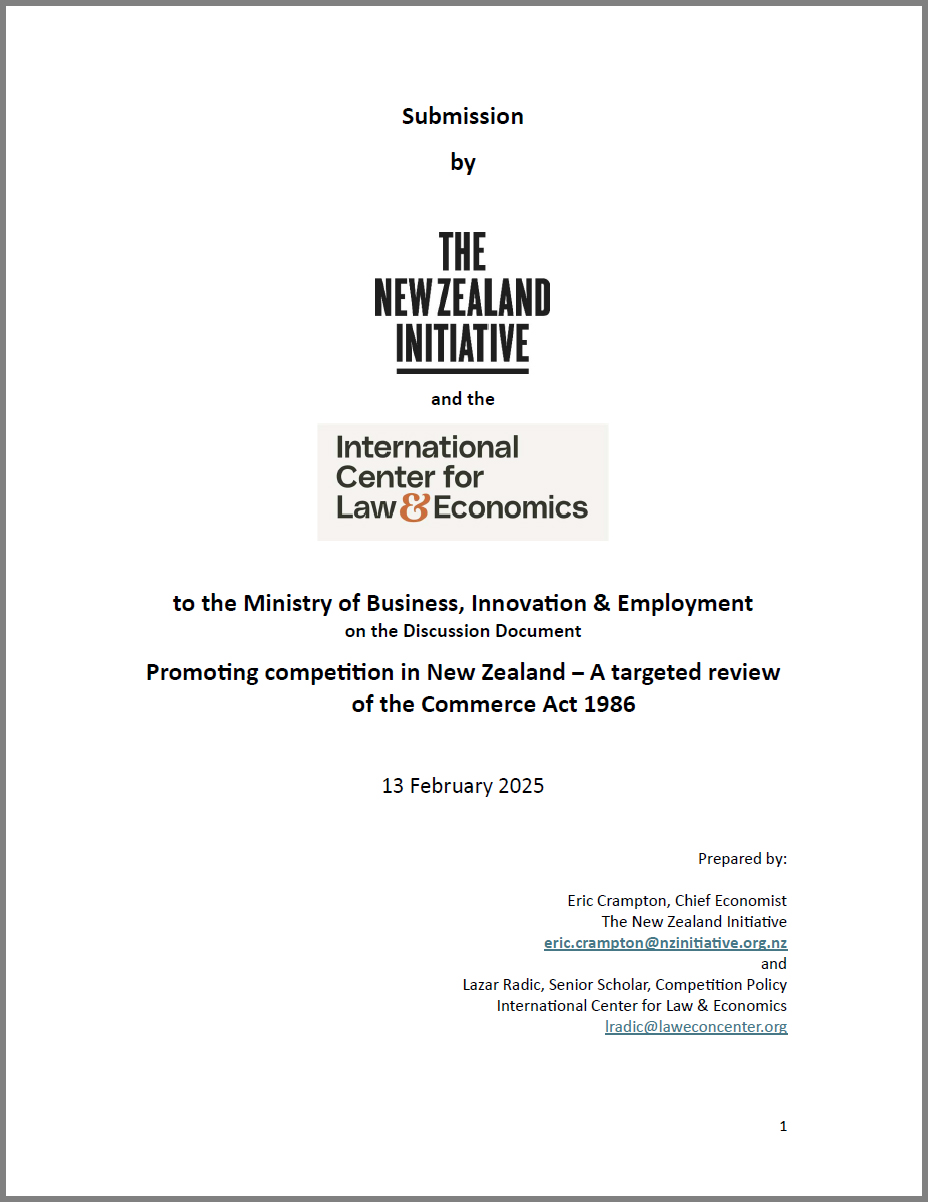1. INTRODUCTION AND SUMMARY
1.1 This submission on the discussion document Promoting competition in New Zealand – A targeted review of the Commerce Act 1986 is made by The New Zealand Initiative (the Initiative), a Wellington-based think tank supported primarily by major New Zealand businesses, and the International Center for Law & Economics [ICLE].
1.2 The Initiative undertakes research that contributes to the development of sound public policies in New Zealand, and we advocate for the creation of a competitive, open and dynamic economy and a free, prosperous, fair and cohesive society.
1.3 The Initiative’s members span the breadth of the New Zealand economy. Our business members are subject to the Commerce Act. The views expressed in this submission are those of the author rather than the New Zealand Initiative’s members.
1.4 The International Center for Law & Economics is a US-based nonprofit, nonpartisan research center working with a roster of more than fifty academic affiliates and research centers from around the globe.
1.4 In summary, we submit that the Review targets secondary, procedural matters instead of the critical first‑order barriers—namely, regulatory and policy‑based constraints— that are the true impediments to a dynamic and competitive market in New Zealand.
1.5 Within the context of the matters addressed by the document, our comments can be summarised as follows:
(a) Regulatory or policy‑based barriers to entry often create or exacerbate the very substantial lessening of competition (SLC) that the Act seeks to prevent. In such cases, rather than imposing extensive regulatory regimes that police market conduct or structure, easing entry barriers is likely to be a more effective solution. Accordingly, when the Commerce Commission identifies that an SLC is driven by
a regulatory regime, it should be empowered to test whether those entry barriers can be relaxed before resorting to more intrusive interventions.
There needs to be a regularised mechanism for the Commerce Commission to report to the responsible Agency or Ministry, or to the Ministry for Regulation, when it encounters an area where a perceived SLC is created or exacerbated by a regulatory regime. There is, to the best of our knowledge, no regular review process for these regulatory regimes testing whether the potential detrimental effects on competition are outweighed by the public benefit sought by the regime,
or whether the restraint on competition remains the most cost-effective way of providing the desired benefit.
When the Commerce Commission identifies regulatory regimes that might result in an SLC, either as part of a market study or as part of another review process, it should be able to request that the Ministry for Regulation review the relevant regime. Easing the regulatory barrier may be the best way of ensuring workably competitive markets. Ben Hamlin’s proposed modernisation of the Crown Exception would help.
(b) New Zealand is a small market and, in many cases, is a ‘regulation-taker’ – meaning that large international companies that also trade in New Zealand face many other regulators, who may or may not have already provided clearance for various mergers or arrangements. But aligning New Zealand’s regime with Australia’s is not the only way of achieving congruence and reducing transactions cost. If a merger is likely to trigger an ACCC test, and approval by both ACCC and the Commerce Commission would be necessary, New Zealand could defer to ACCC’s ruling.
But for mergers between New Zealand companies with no Australian
entanglements, there seems no obvious need for New Zealand’s framework to align with Australia’s. Instead, New Zealand should tailor its framework to local market conditions. This local tailoring ensures that mergers beneficial to NZ consumers are not blocked simply due to incongruency with foreign standards.
(c) A consumer‑welfare focus is critical given that market structure is only an imperfect proxy for competitive harm. Merger control should focus on safeguarding competition and consumer welfare rather than achieving particular market structures. And where the Commission may not have resource to pursue all potential SLCs, it should focus first on those that do most harm to consumer welfare.
(d) Without vigilant, ongoing review, industry codes or rules risk evolving into de facto coordination mechanisms that can further entrench existing market power. This is a particular worry for industries facing a common regulator that can serve as additional enforcement mechanism for anticompetitive conduct by blocking new entry.




